Discovering the Rich Culinary Heritage of the UAE
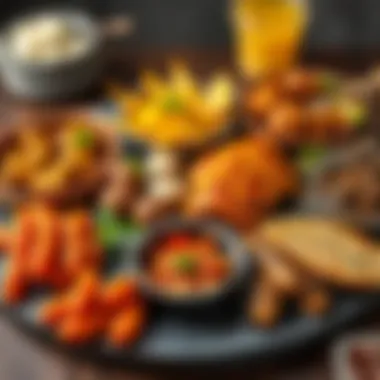
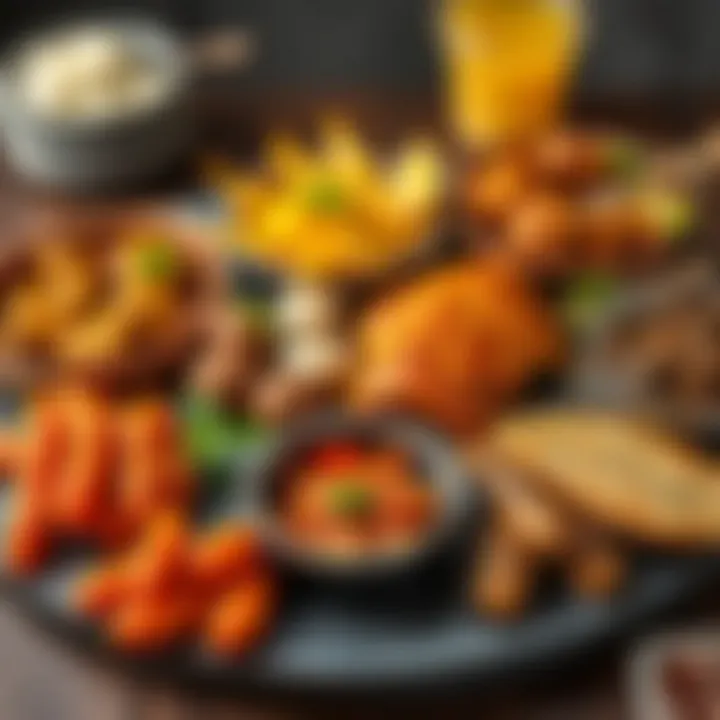
Intro
In the heart of the Middle East lies the United Arab Emirates (UAE), a melting pot of tradition and modernity, where ancient customs meet contemporary influences. The culinary scene in the UAE serves as a microcosm of its rich culture, revealing a tapestry woven with history, regional availability, and globalization. The Emirati kitchen is not just about eating; it embodies the spirit of hospitality, family ties, and communal gatherings. Through this exploration of the UAE's culinary heritage, we will discover how food transcends mere sustenance, offering insights into the very identity and values of its people.
As we set the stage for this gastronomic journey, we will delve into various aspects of Emirati cuisine: its historical roots, the ingredients that play a crucial role, and the evolution of traditional dishes. Additionally, we will examine how contemporary trends and the principles of globalization have influenced the local food landscape, all while maintaining a deep reverence for tradition. Understanding these elements offers a clearer picture of how food culture parallels the broader societal makeup of the UAE. Thus, our exploration encompasses more than just recipes; it is an invitation to taste the history, diversity, and innovation that define Emirati cuisine.
Preamble to the Culinary Landscape of the UAE
The culinary scene in the United Arab Emirates is a vibrant tapestry woven with threads of history, culture, and community. Understanding this landscape goes beyond just tasting the dishes; it's about grasping the essence of the UAE's identity wrapped in the flavors and aromas that fill its kitchens. Food plays a central role in daily life here, acting as a bridge between generations and a vital element of social interactions. For many, mealtime isn't merely about nourishment; it's a ritual that bonds family and friends, symbolizing hospitality and warmth that the UAE is renowned for.
In any society, cuisine serves as a reflection of its people, their journeys, and their experiences. The UAE illustrates this beautifully, showcasing a fusion of native customs alongside influences from various cultures due to its location as a historical crossroads for trade. The significance of food in shaping the sense of belonging and cultural pride cannot be overstated. It’s not unusual for families to pass down recipes, telling their stories through each ingredient and preparation method.
The culinary heritage of the Emirates is particularly rich and dynamic. A potent blend of traditional Bedouin practices, coastal influences from its maritime history, and more recent global trends make this region’s cooking unique. Notably, Emirati cuisine showcases regional ingredients, highlighting the importance of local agriculture and fishing, which further entwines food with the environmental context.
Through this exploration of the UAE's culinary landscape, we'll uncover various dimensions: the historical influences that have shaped current practices, the unique ingredients that define traditional dishes, and how globalization is re-contextualizing these traditions. This journey into food culture enriches our understanding not only of what the people of the UAE eat but also of who they are—their values, beliefs, and the communal ties that culinary practices encourage.
Significance of Food in Culture
Food in the UAE transcends sustenance; it is a cornerstone of hospitality, contributing actively to the cultural identity of the nation. Not just a side show, meals are central to gatherings, celebrations, and an array of life events, expressing generosity and communal spirit.
"In the embrace of shared meals, cultural stories come to life."
Dishes are often prepared with meticulous care, inviting family and friends to partake in the experience. The act of serving food, especially to guests, is an invocation of respect and honor, underscoring the Emirati ethos of hospitality. Festivals are often marked not only by rituals but also by an abundance of food, generating a sense of togetherness amongst diverse communities, allowing different backgrounds to be brought forth in unity.
Moreover, social norms around eating reflect values such as generosity, respect, and family bonding, all echoing throughout the warm, welcoming homes across the Emirates. This alludes to how food connects generations, as recipes and cooking techniques evolve over time, while still paying homage to traditions.
Overview of Emirati Cuisine
Emirati cuisine is a colorful mosaic that reflects the historical and geographical influences evident in the UAE. It is primarily characterized by its simplicity, richness in flavor, and the use of various spices—elements that stem from its strategic trading location. The dishes often incorporate ingredients from the land and sea, showcasing both the agricultural richness and the proximity to the Arabian Gulf.
Some common cooking methods include grilling, stewing, and slow cooking – techniques that enhance the flavor profiles and are rooted in Bedouin heritage. Traditional staples like rice, lamb, chicken, and seafood feature prominently, presenting a blend of hearty and aromatic profiles that define local cuisine. Traditional dishes often served at gatherings include Al Harees and Majboos, each telling a story of culture and tradition.
Furthermore, contemporary twists are increasingly appearing in Emirati kitchens as chefs embrace global culinary trends, leading to a culinary renaissance. This evolving approach does not dilute the essence of traditional cooking; rather, it enriches it, paving the way for new interpretations while preserving the values associated with Emirati hospitality.
Through this article, the scope of our exploration will reveal how dining habits and culinary practices encapsulate the spirit of a nation, all the while cherishing its roots against the backdrop of modernity.
Historical Influences on UAE Cuisine
The culinary landscape of the UAE is not merely a collection of dishes but rather a rich tapestry woven from various historical threads. Understanding the historical influences on UAE cuisine sheds light on its evolution and the myriad flavors that characterize it today. This section serves as a compass, guiding us through the pivotal factors that honed its unique identity. By exploring trade routes and cultural exchanges, alongside the deep-rooted Bedouin heritage, we find that the context of these influences plays a vital role in how food intermingles with culture.
Trade Routes and Cultural Exchange
Trade routes have been instrumental in shaping the culinary experiences of many cultures, and the UAE is no exception. Historically, the region has been positioned as a strategic hub between the East and West. This advantage provided an ideal environment for merchants to exchange not just goods but culinary practices as well. The spice trade, in particular, brought an influx of ingredients from far-flung lands.
As spices traveled along the ancient Silk Road, they introduced new flavors and cooking techniques to the Arab world. For instance, ingredients such as saffron, cardamom, and sumac began making their way into local Emirati dishes, transforming the very essence of traditional cooking. The importance of this exchange cannot be overstated. The emulation and adaptation of foreign culinary traditions were significant because they helped the UAE’s food scene evolve.
Moreover, cultural exchanges stemming from these trade routes influenced social gatherings. Food became a medium for showcasing wealth and hospitality. It was common for travelers to be received with generous feasts that exemplified the region’s vibrant trade connections. This practice ultimately reinforced the significance of food in Emirati culture, as sharing a meal transcended mere sustenance and turned into an act of companionship and communal harmony.
Bedouin Heritage and Traditional Cooking Methods
Emirati cuisine carries the fingerprints of its Bedouin heritage, where the art of cooking was shaped by a nomadic lifestyle and the harsh desert environment. For the Bedouins, food was not just about nourishment; it was about survival, creativity, and adaptability. Traditional cooking methods such as the use of a tabikh, an underground oven, underscore these qualities.
Culinary techniques like slow-cooking meats in a dawad—a method utilizing the heat of the desert sun for an extended period—reveal how the Bedouins ingeniously used their surroundings to their advantage. Items like lamb and goats were commonly prepared this way, resulting in tender and flavorful meals that were easy to prepare in a transient lifestyle.
Furthermore, the concept of hospitality among the Bedouins adds another layer of richness to understanding this culinary heritage. Sharing food was a mark of respect and goodwill; even the simplest meal was served with a generous handful of dates or a steaming pot of jash—a dish made with rice and meat.
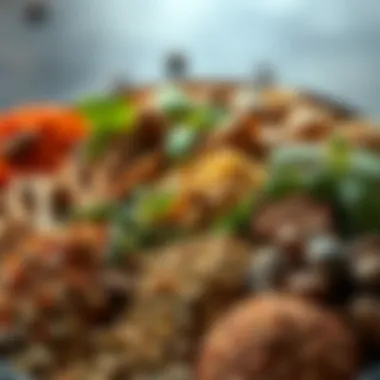
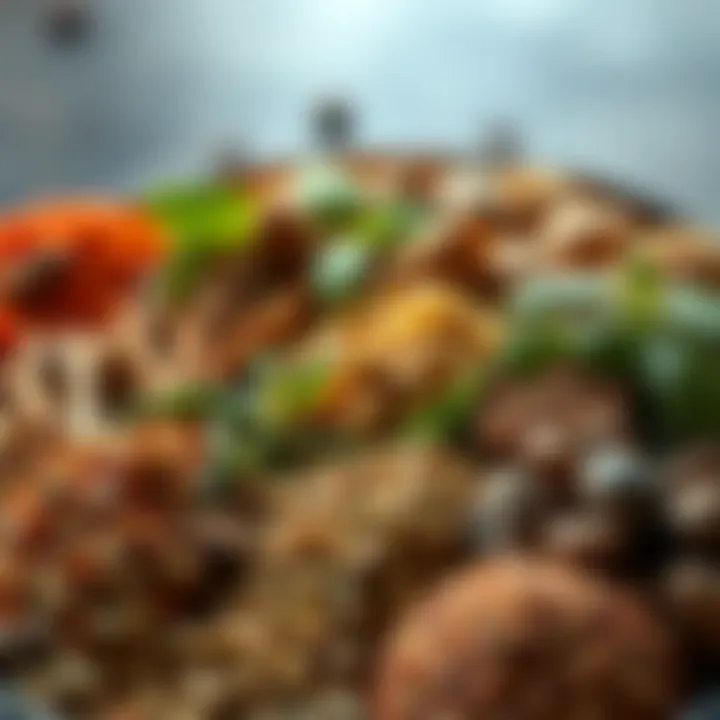
"Food is a gift; offering it is a gesture of friendship in Emirati culture."
Key Ingredients in Emirati Dishes
The essence of Emirati cuisine lies not just in the breadth of its flavors but also in the key ingredients that make it distinct. Each component tells a story, weaving together the history, culture, and environment of the UAE. Understanding these ingredients provides a deeper appreciation of the culinary landscape and the ways in which it reflects the values and traditions of Emirati society.
Spices and Herbs
Emirati dishes are known for their rich and aromatic spices, which are essential to bringing life to every meal. Spices like cumin, coriander, saffron, and cardamom elevate flavors and provide warmth. Moreover, these ingredients often represent a blend of the indigenous and imported, showcasing the UAE's historical trade routes. The careful balance of spices not only enhances taste but also serves as a hallmark of Emirati culinary art.
"In the world of food, spices are the unsung heroes, shaping flavor profiles that are uniquely ours."
The use of fresh herbs like cilantro and mint adds brightness, cutting through the richness of meat dishes and elaborate rice preparations. Understanding how spices and herbs interact in dishes offers insights into the cultural significance, as they often symbolize hospitality and generosity.
Staples of the Emirati Pantry
Rice
Rice stands as the backbone of many Emirati meals. It’s not just a filling accompaniment but the main player in dishes such as Majboos, where it absorbs spices and infuses with flavors. Its versatility allows it to be prepared in various styles, whether steamed, spiced, or baked. The key characteristic of rice is its ability to complement a variety of ingredients without overshadowing them.
One unique feature of rice in Emirati cooking is the variety used, such as Basmati, celebrated for its long grains and aromatic profile. This specific type of rice contributes to the authenticity of the dish, offering a fragrant base that supports the spices and meats beautifully.
Meat
Meat is another staple that takes center stage in Emirati cuisine. Lamb, chicken, and beef are commonly used, often slow-cooked to tenderness, allowing flavors to meld beautifully. The key characteristic of meat in these dishes is its rich, hearty quality, providing sustenance and warmth, which is particularly cherished in social gatherings.
What sets Emirati meat dishes apart is the method of preparation, typically incorporating marination with spices unique to the region, thus enhancing its taste. A notable aspect of this ingredient is its sociocultural significance; sharing a meat dish often represents generosity and hospitality.
Dates
Dates are more than just a sweet treat; they are a significant part of the Emirati diet and culture. Known for their high nutritional value, these fruits serve as energy boosters and have a special place during Ramadan and other festive occasions. The key characteristic of dates is their natural sweetness which can complement various savory dishes.
Moreover, dates are often served alongside coffee, symbolizing hospitality. Their unique features include a myriad of varieties, each with distinct flavors and textures, providing a rich culinary experience that connects the past with the present.
Fish
Given its geographical location, the UAE boasts a seafood-rich culture. Fish such as hamour and sheri feature prominently in traditional cooking. The key characteristic of fish is its freshness, as coastal access allows for locally sourced ingredients, bringing flavors that resonate with the culinary heritage.
Unlike meats, fish cooks quickly and is often seasoned lightly to highlight its freshness, making it a preferred choice for meals that are both satisfying and healthy. One unique aspect is the participation in traditional fishing methods, fostering a connection to heritage and community lifeways.
In summary, the ingredients integral to Emirati dishes play a critical role in expressing the UAE's cultural identity. By emphasizing fresh, local products like rice, meat, dates, and fish, EMirati cuisine continues to evolve while preserving its rich traditions. Each ingredient contributes its own story, flavors, and history, enhancing the culinary narrative of the region.
Traditional Emirati Dishes
Traditional Emirati Dishes hold a significant place in the cultural mosaic of the UAE. They serve not merely as a means of sustenance but tell stories of heritage, identity and the land's history. These dishes reflect the diverse influences that have shaped Emirati cuisine, showcasing the importance of community, family, and tradition.
Each dish is emblematic of the values cherished by the Emirati people—hospitality and unity. For instance, meals are often prepared not just for those who are present but with the expectation that an extended family or friends may gather. In doing so, they symbolize bonding and a shared experience. Furthermore, traditional Emirati meals often feature alongside major events, making them integral to festivals and celebrations.
Al Harees: A Symbol of Unity
Al Harees is one of the most cherished dishes in Emirati cuisine, often seen on tables especially during festive occasions like Ramadan and weddings. The dish consists of wheat and meat, cooked meticulously to create a flavorful porridge-like consistency. Preparing Al Harees is no small feat; it involves soaking wheat overnight, carefully adding meat, and slow-cooking the mixture to perfect blending.
This dish epitomizes the spirit of unity in Emirati society. It is common for families to prepare large quantities and share them with neighbors and friends, reinforcing social bonds and a sense of community. It serves as a reminder that food is not just about eating; it's about gathering and sharing experiences with loved ones.
Majboos: The Spiced Rice Delight
Majboos, also known as Kabsa in other parts of the Gulf, is a vibrant rice dish flavored with an array of spices such as saffron, cardamom, and cinnamon. It typically includes a protein source like chicken, lamb, or fish, making it a versatile option for various palates. Majboos is not just a meal; it’s an experience steeped in rich cultural norms.
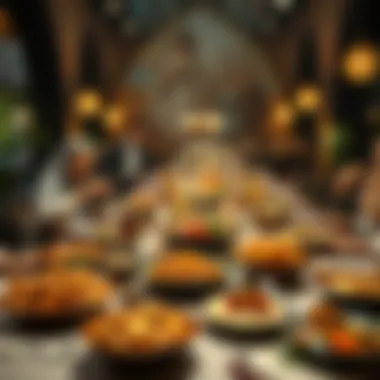
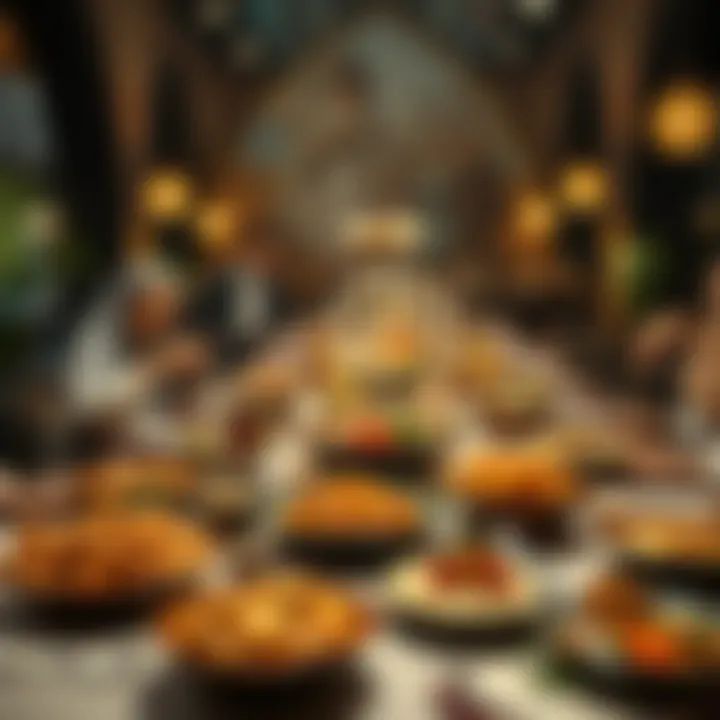
Traditionally, families prepare this dish together, fostering a sense of togetherness. It's said that how the Majboos is served can reflect the family's hospitality. Often, the dish is presented on a large communal platter, allowing guests to serve themselves, signifying generosity and warmth—a hallmark of Emirati culture.
Shawarma: A Global Favorite
Shawarma has become a culinary icon not only in the UAE but worldwide. This dish consists of marinated meat that is cooked on a vertical rotisserie, typically served wrapped in pita bread along with vegetables and sauces. Though it has roots in Middle Eastern cuisine, its adaptability has allowed it to become a global favorite.
In the UAE, street vendors and restaurants sell Shawarma, and it’s often enjoyed after a long day or during gatherings. It showcases how traditional Emirati dishes have evolved and been embraced by different cultures, bridging culinary practices while maintaining connections to their origins. Shawarma highlights the intersection of tradition and modernity in the culinary landscape, illustrating how diverse flavor profiles can coexist harmoniously.
Eating in the UAE is more than just satisfying hunger; it's a means of celebrating culture through flavors, customs, and shared experiences.
Each traditional dish not only satisfies the palate but also serves as a conduit through which cultural stories and family traditions are handed down through generations. This dynamic blend of flavors, events, and practices enriches the fabric of Emirati culture.
Role of Food in Social and Cultural Contexts
Food is more than just sustenance in the United Arab Emirates; it is a linchpin of social interaction and cultural expression. In the UAE, meals often gather families, neighbors, and friends under one roof, fostering a sense of community and shared identity. The way food is prepared, presented, and enjoyed reflects the deep-rooted traditions and values of Emirati society.
Hospitality and Generosity
Emiratis take pride in their hospitality, where offering food is a significant ritual. When guests arrive at a home, they are typically greeted with dates and Arabic coffee, or "gahwa," which signifies warmth and welcome. Sharing food—especially traditional dishes like Al Harees—is seen as a gesture of generosity and respect.
The expectation of unsurpassed hospitality in Emirati culture influences not just social gatherings, but community events too. It's customary for families to invite friends and neighbors to feast together, reinforcing bonds and promoting inclusivity. This hospitality often extends to strangers and visitors, showcasing the open-hearted nature of Emirati people.
"Food transcends boundaries and connects cultures; in the UAE, it embodies the spirit of community."
Throughout various settings, gatherings centered around meals yield a sense of belonging, as shared food experiences become treasured memories. In a fast-paced, modern world, maintaining these traditions offers a comforting reminder of one’s roots and cultural identity.
Food in Festivals and Celebrations
Food plays a pivotal role in several Emirati celebrations, framing how heritage is passed down through generations. From extraordinary feasts to the simplest gatherings, each event centers on particular dishes that resonate with cultural significance.
Eid Al Fitr
Eid Al Fitr marks the end of Ramadan, a month of fasting. It is a day of feasting with family and friends, where meals are shared to celebrate the end of this spiritual journey. The preparation of dishes like Knafeh and Biryani is a labor of love that illustrates cultural pride. This festival not only embodies the joy of breaking the fast but also serves as a vehicle for expressing gratitude and generosity towards others.
Eid Al Adha
Similar to Eid Al Fitr, Eid Al Adha brings families together to share food. However, this celebration is particularly associated with the ritual of Qurbani, which involves the sacrifice of an animal in remembrance of Prophet Ibrahim's faith. Lamb and chicken dishes are often served to signal the importance of sacrifice and community sharing. The act of feeding others during Eid Al Adha emphasizes selflessness and charity, crucial values in Emirati culture.
National Day
On National Day, the UAE unites to celebrate its formation. Traditional foods are an integral part of this festivity, with dishes like Tabbouleh and Hummus gracing many tables. National Day meals serve not just to honor the nation, but also to showcase the cultural melting pot that is the UAE. It's a time when food takes on the essence of unity, where diverse culinary delights symbolize the country's rich heritage.
In all these celebrations, food does more than fuel the body. It acts as a connection to identity, history, and community, underscoring the intertwined relationship between the culinary landscape and the Emirati way of life.
Contemporary Trends in Emirati Cuisine
The evolution of Emirati cuisine is a story of its own—woven with threads of history, culture, and modern influences. Recently, there has been a rise in contemporary trends within Emirati culinary practices, and this segment brushes over how these trends shape the identity of food in UAE. There's more to food than just nourishment; it plays a role in community building, economic development, and cultural exchange.
The Fusion of Modern and Traditional
In today’s culinary scene in the UAE, the blending of modern approaches with traditional techniques is quite a phenomenon. It’s not unusual to find a dish featuring saffron-infused risotto served alongside a fragrant lamb dish seasoned with traditional spices. Chefs, both local and from abroad, have taken to marrying Emirati flavors with global cuisines, creating a melting pot of culinary experiences.
Take, for example, the increasing popularity of Emirati-inspired sushi rolls, which incorporate local ingredients like za'atar and sumac. These dishes serve not only to attract tourists looking for a taste of local flavor but also to appeal to the younger Emirati diners who appreciate innovation in their culinary experiences.
Furthermore, many new restaurants aim to preserve the essence of traditional cooking while making it accessible for younger generations. This trend can be observed in upscale dining establishments that recreate age-old recipes using modern plating techniques and local organic produce.


This infusion of contemporary practices into traditional Emirati fare captures a crucial element: nostalgia. People reminisce about their childhood flavors while embracing new ones, creating a culinary tapestry that reflects their evolving identity.
Influence of Globalization on Food Culture
Globalization has undoubtedly left its mark on Emirati cuisine, ushering in a myriad of influences that both enrich and complicate its traditional landscape. As the UAE becomes a bustling hub for expatriates from around the world, dishes from different cultures have found a home on Emirati tables.
In the heart of Dubai, you might find a vibrant food market displaying everything from Indian biryanis to Italian pastas, all flavored with a hint of Emirati hospitality. The lines between international and local dishes have blurred, leading to hybrid creations such as biryani pizza, which has gained unprecedented popularity among those who enjoy the unexpected mingling of flavors.
Moreover, social media has played a pivotal role in this culinary globalization. Instagram-worthy presentations of classic dishes attract not only locals but also visitors who want to voice their experiences to their followers. The emphasis on food aesthetics has prompted chefs to strive for creativity and excellence, pushing Emirati cuisine into the digital age.
Quote: "Food is the essence of every culture, and in UAE, it represents a bridge between what was, what is, and what can be."
Today, sustainability is also on everyone’s radar, meaning that as cuisines merge, environmental considerations enter the equation. Restaurants increasingly pride themselves on sourcing local ingredients, reducing food waste, and practicing eco-friendly methods. The heightened awareness of health and wellness shapes not only the ingredients but also cooking methods; steaming, grilling, or sautéing have become preferred choices over frying.
As Emirati cuisine continues to evolve, it stands at the intersection of tradition and modernity, becoming a delicious representation of a society in flux. In essence, the contemporary trends in Emirati cuisine highlight resilience, adaptability, and the continuous quest for culinary excellence.
City dwellers and international tourists alike are drawn into this culinary narrative, where tradition is not merely preserved but continuously rewritten to reflect the tastes and values of a modern society.
Health and Sustainability in Emirati Cooking
In the context of UAE's culinary landscape, health and sustainability have become pivotal pillars that underscore the evolving nature of Emirati cooking. As the world increasingly leans toward organic food practices and sustainability, so too does Emirati cuisine embrace these trends, intertwining health with cultural authenticity. The focus on sourcing fresh, local ingredients and the pivot towards healthy eating reflect not only a desire for better health outcomes but also a commitment to preserving the environment, making Emirati cooking not just a way of life, but a conscious choice for the future.
Emphasis on Fresh, Local Ingredients
UAE's climate provides a unique opportunity for cultivating a plethora of fresh produce that is locally sourced and comes with flavors that tell a story of the land. Farmers' markets and local shops increasingly stock ingredients that are seasonal, encouraging a diet rich in fruits and vegetables. This emphasis on fresh ingredients enhances the nutritional value of dishes. Here are some of the locally cultivated staples:
- Dates: Traditionally significant, they are more than just a sweet treat; packed with fiber and essential nutrients, dates are a powerhouse of energy.
- Fresh Fish: The coastal regions offer an abundant supply of fish species, promoting a diet that is high in omega-3 fatty acids.
- Herbs and Greens: Many Emirati dishes are now incorporating locally grown herbs such as mint and coriander, which adds both flavor and nutrition.
By focusing on locally sourced products, chefs can create meals that not only support their community but also flavor the culinary experience with regional authenticity. This practice cuts down on carbon footprints associated with transporting food, contributes to the economy, and fosters a sense of community among local farmers and consumers.
Trends towards Healthy Eating
As the UAE continues to modernize and globalize, there is a noticeable shift in dietary preferences among Emiratis and residents alike. Traditional Emirati cuisine is now making strides towards being more health-conscious without sacrificing taste. This trend has been fueled by increasing awareness of health and wellness, particularly among younger generations.
Some key aspects of this shift include:
- Reduction of Processed Foods: Many are moving away from processed and fried foods, opting instead for baked or grilled items, fostering healthier cooking methods.
- Integration of Superfoods: Ingredients like quinoa, kale, and chia seeds are being incorporated into traditional recipes, increasing nutrient density.
- Mindful Eating: UAE's gastronomic community promotes awareness around portion sizes and the nutritional content of meals, pushing the envelope beyond mere sustenance.
The renewed focus on health in Emirati cooking not only benefits individual well-being but also aligns with global health initiatives, making UAE a beacon in the culinary world.
End: The Future of Emirati Cuisine
The future of Emirati cuisine stands at a fascinating crossroads that reflects both its rich heritage and the inevitable influences of modernity. At this juncture, the ongoing dialogue between preserving tradition and embracing innovation creates a culinary landscape that is not just a reflection of Emirati culture, but also a canvas for growth and creativity.
Preserving Tradition While Embracing Change
One of the most crucial aspects about this evolution is the delicate balance between safeguarding the timeless recipes passed down through generations and allowing room for creative interpretations. Traditional dishes like Al Harees and Majboos carry with them stories of community and identity. However, as the younger generations explore culinary arts, there is a noticeable influence of global flavors.
The resurgence of interest in ancient cooking methods and local ingredients is noteworthy. Many young chefs are keen to honor their roots. They revisit traditional techniques while adapting their approach to cater to contemporary tastes. A classic example can be seen in how dates, a staple of Emirati culture, are now being incorporated into gourmet desserts. This mix keeps Emirati identity alive while drawing the attention of food enthusiasts from around the world. In this way, the culture is not static; rather, it evolves and grows, reflecting both authenticity and modern flair.
Culinary Tourism as a Catalyst for Growth
The impact of culinary tourism has emerged as a significant player in shaping the future of food culture in the Emirates. Travelers come from far and wide not only to experience the landscapes but also to partake in the gastronomic offerings unique to the region. The rise of food festivals and culinary tours highlights Emirati cuisine's potential. These occasions showcase the rich ingredients, traditional methods, and modern innovations that define the culinary scene.
Culinary tourism not only boosts local economies but also fosters cultural exchange. Visitors often leave with an appreciation for Emirati traditions and its hospitality, giving rise to a deeper global understanding of the culture. Through these interactions, chefs and home cooks gain insights into international cooking styles, inspiring a cross-pollination of techniques and ideas that can benefit the local culinary landscape.
In summary, the future of Emirati cuisine is a promising blend of preserving the past while navigating the winding roads of innovation. As the nation continues to grow, its food culture will likely mirror this evolution, standing as a testament to resilience, creativity, and everlasting cultural pride. Whether through the tables of homes or the bustling markets, Emirati cuisine will remain an integral part of the narrative, inviting everyone to partake in its rich heritage and innovative spirit.
"Food is more than just sustenance; it is a gateway to understanding a culture."
For more information about Emirati cuisine, you may visit resources like Britannica or Wikipedia.
Consider learning more about the cultural aspects of food at Reddit and connecting through social media platforms.







